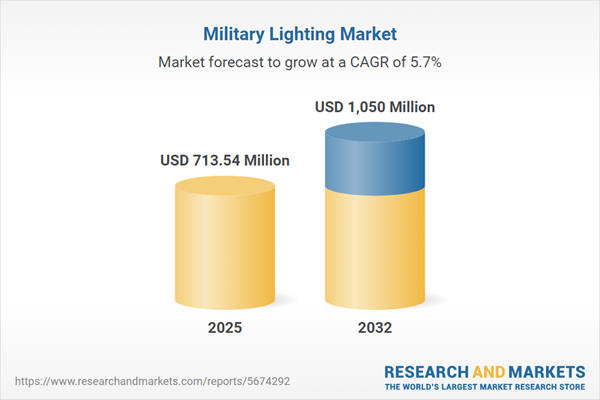Speak directly to the analyst to clarify any post sales queries you may have.
Military lighting market trends are evolving rapidly, driven by the need for smarter, more energy-efficient systems that enhance adaptability for modern defense operations. Senior leaders increasingly prioritize the integration of advanced lighting to ensure resilient mission support as technology and strategic demands shift globally.
Market Snapshot: Military Lighting Market Size and Growth
The global military lighting market is positioned for steady growth, underpinned by active modernization programs across defense sectors. With a current market valuation of USD 674.79 million in 2024 and projected to reach USD 713.54 million by 2025, the sector records a compound annual growth rate (CAGR) of 5.72%. Forecasts anticipate continued expansion, with expectations for the market value to reach 1.05 billion USD by 2032. Investments in defense upgrades and the emphasis on operational resilience are accelerating demand for ruggedized, energy-efficient lighting, supporting the integration with both established and next-generation military systems.
Scope & Segmentation of the Military Lighting Market
- Product Type: Automated lighting control systems and durable lamp technologies, including fluorescent, incandescent, halogen, and LED luminaires, provide essential reliability for fixed installations and remote missions.
- Application: Lighting solutions enable equipment maintenance, support night-vision operations, enhance tactical mission performance, and facilitate signaling, all tailored for a diverse range of defense activities.
- Light Source: Options such as LED, halogen, incandescent, and fluorescent cater to varied efficiency and performance needs in challenging military environments.
- Platform: Specialized systems are designed for aircraft—both fixed-wing and rotary—UAVs, ground vehicles, naval assets, and wearable military gear, meeting rigorous standards for each use case.
- End User: The military lighting sector delivers customized solutions for Air Force, Army, Navy, Marine Corps, and private defense contractors, ensuring alignment with unique operational objectives.
- Distribution Channel: Procurement is streamlined via direct purchases, specialty distributors, and digital platforms to improve supply chain speed and flexibility in urgent deployments.
- Geographic Coverage: The market encompasses the Americas, Europe, Middle East, Africa, and Asia-Pacific. Key markets like the United States, Canada, China, Japan, India, Germany, and the United Kingdom exhibit diverse regulatory priorities and adoption strategies, shaping provider decision-making and deployment approaches.
- Company Coverage: Major industry players—Raytheon Technologies, BAE Systems, Thales Group, L3Harris Technologies, Leonardo S.p.A., Elbit Systems, OSRAM GmbH, Eaton Corporation, Curtiss-Wright, and Signify N.V.—influence technology standards and ongoing defense lighting innovation.
Key Takeaways for Senior Decision-Makers
- Integration of solid-state and intelligent lighting controls allows systems to function across legacy and new defense platforms, adding operational flexibility for mission teams.
- Interoperable lighting architectures reduce complexity, supporting multi-platform assets and enhancing mission security through performance consistency and improved cyber resilience.
- Adopting procurement strategies focused on product lifecycles helps ensure reliable service, minimize maintenance disruptions, and align with environmentally responsible asset management goals.
- Customization, including modular lighting designs, facilitates compliance with regulatory standards and supports rapid adaptation to evolving operational requirements among various service branches.
- Collaborative innovation between government stakeholders, approved suppliers, and sector technology partners sustains the pace of product advancement and bolsters supply network resilience.
Tariff Impact: U.S. Policy and Supply Chain Response
The evolving U.S. tariff landscape for lighting and electronic components contributes to increased procurement complexity in the defense sector. Organizations are proactively expanding supplier networks, prioritizing domestic sourcing options, and building inventory reserves. Incorporating modular and adaptive lighting solutions also allows procurement teams to remain agile and compliant with shifting policy requirements, strengthening mission readiness under new regulatory pressures.
Methodology & Data Sources
This analysis draws on data from procurement officials, leading manufacturers, and system integrators active in the military lighting sector. Supporting information comes from verified supplier records, defense regulations, technical documentation, and exclusive industry sources to provide practical and credible market insight for decision-makers.
Why This Report Matters
- Empowers senior decision-makers to interpret market direction, understand procurement trends, and respond effectively to compliance and regulatory shifts within the military lighting market.
- Presents actionable frameworks for strengthening supply chain stability, improving acquisition planning, and guiding product evolution to sustain defense priorities and technical requirements.
- Enables organizations to uphold operational continuity and proactively address emerging challenges, ensuring readiness in both technology deployment and regulatory environments.
Conclusion
This report offers valuable direction for leaders seeking to introduce advanced military lighting solutions and uphold strong operational outcomes as mission and technology needs transition over time.
Additional Product Information:
- Purchase of this report includes 1 year online access with quarterly updates.
- This report can be updated on request. Please contact our Customer Experience team using the Ask a Question widget on our website.
Table of Contents
3. Executive Summary
4. Market Overview
7. Cumulative Impact of Artificial Intelligence 2025
Companies Mentioned
The companies profiled in this Military Lighting market report include:- Raytheon Technologies Corporation
- BAE Systems plc
- Thales Group
- L3Harris Technologies, Inc.
- Leonardo S.p.A.
- Elbit Systems Ltd.
- OSRAM GmbH
- Eaton Corporation plc
- Curtiss-Wright Corporation
- Signify N.V.
Table Information
| Report Attribute | Details |
|---|---|
| No. of Pages | 199 |
| Published | October 2025 |
| Forecast Period | 2025 - 2032 |
| Estimated Market Value ( USD | $ 713.54 Million |
| Forecasted Market Value ( USD | $ 1050 Million |
| Compound Annual Growth Rate | 5.7% |
| Regions Covered | Global |
| No. of Companies Mentioned | 11 |









